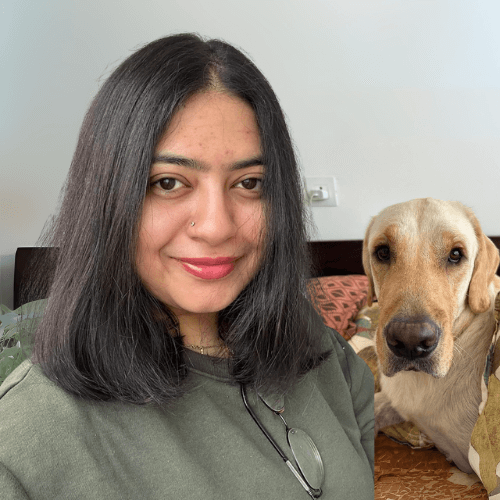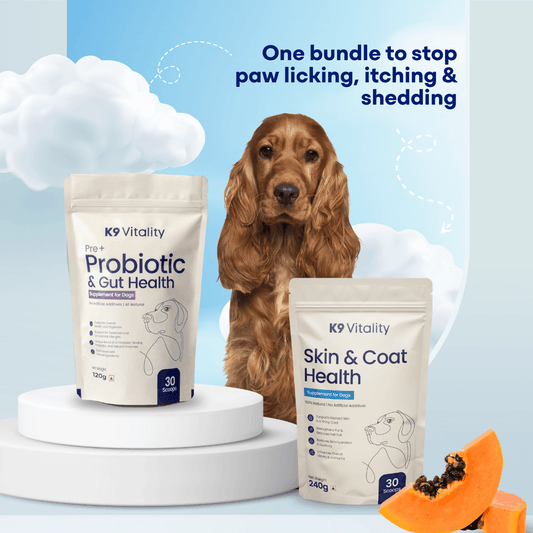
What Are the Signs of Yeast-Related Dog Fungal Skin Infection and the Best Treatments?
Share
Do You Know What Yeast-Related Skin Infections Look Like in Dogs and Why It's Crucial to Treat Them?
As a loving pet parent, you know when your furry companion is feeling off, but what if the problem lies skin-deep and invisible to the untrained eye?
Do you know what yeast-related dog fungal skin infections look like, how they work, and why timely treatment is critical?
These infections can be stubborn, uncomfortable, and often misdiagnosed. Ignoring them can evolve into a chronic, painful condition that severely impacts your dog’s quality of life. That’s where K9 Vitality steps in. We’re not just another pet care brand, we are your guide and partner in navigating canine health, backed by real expertise and real solutions.
In this guide, we’ll break down everything pet parents need to know about yeast-related fungal skin infections in dogs, from spotting the early signs to choosing the right treatment backed by science and aligned with our specialized K9 Vitality product line.
What Is a Yeast Infection in Dogs?

A yeast infection in dogs is primarily caused by the overgrowth of Malassezia pachydermatis, a fungus that lives on the skin. While it's typically harmless, an imbalance in the skin microbiome or a compromised immune system can allow this yeast to multiply and trigger an infection.
Common Causes:
- Allergies (food or environmental)
- Excess moisture in skin folds
- Weak immune system
- Overuse of antibiotics
- Poor grooming or nutrition
- Hormonal imbalances (e.g., hypothyroidism)
Recognizing the Signs: Symptoms You Should Never Ignore
Identifying yeast infections early is the key to fast relief and effective treatment. Here are the signs to watch for:
1. Itching and Scratching
- Intense scratching around ears, paws, and groin
2. Musty Odor
- A distinct cheesy or moldy smell
3. Greasy or Flaky Skin
- Oily skin or dandruff-like texture
4. Redness and Inflammation
- Red, swollen, and warm irritated areas
5. Hair Loss or Bald Patches
- Especially near tail, belly, or underarms
6. Thickened or Darkened Skin
- Chronic infections may cause thick or dark patches
7. Head Shaking and Ear Infections
- Common in moist ear canals
8. Brown Discharge in Ears or Between Toes
- Sticky, waxy residue present
9. Licking and Chewing at Paws
- Common if yeast spreads to nails or between pads
10. Lethargy or Behavioral Changes
- Less playful or irritable due to discomfort
Why It Matters: The Danger of Ignoring Yeast Infections

Untreated yeast infections can:
- Become chronic and harder to treat
- Lead to secondary bacterial infections
- Cause long-term skin damage
- Indicate underlying health issues
More importantly, untreated discomfort means your dog is suffering unnecessarily.
Best Treatments for Yeast-Related Fungal Infections in Dogs
1. Accurate Diagnosis
Consult a vet. Skin scrapings or cytology confirm yeast versus mites, bacteria, or allergies.
2. Vet-Recommended Medications
- Topical antifungals such as chlorhexidine or miconazole shampoos and wipes
- Oral antifungals such as ketoconazole or fluconazole for advanced cases
3. Internal Support Through Diet and Supplements
- Switch to a low-carb, high-protein diet
- Support gut and skin health with high-quality supplements
K9 Vitality's Role: Targeted Natural Products
At K9 Vitality, we approach dog wellness holistically. Our products target the root causes of skin imbalance.
A. Gut Health Support
Pre + Probiotics & Gut Health For Dogs rebalance gut flora to limit yeast overgrowth.
B. Skin Repair and Maintenance
Skin & Coat Health Supplement for Dogs improves skin hydration, reduces itching, and restores fur shine.
C. Complete Care Duo
Probiotics + Skin & Coat Duo for Dogs addresses both internal and external factors of chronic skin issues.
Essential Home Care Tips for Managing Yeast Infections

Cleanliness:
- Bathe with vet-recommended antifungal shampoo
- Keep ears and skin folds dry and clean
Dietary Discipline:
- Avoid high starch and sugar treats
- Use grain-free, hypoallergenic diets
Routine Monitoring:
- Check skin and paws weekly
- Note any signs of recurrence
- Stay consistent with diet and supplements
Final Thoughts: Let K9 Vitality Guide You
Yeast-related skin infections are not cosmetic. They signal deeper imbalance and discomfort. With early detection, consistent care, and targeted treatment, your dog can recover and thrive.
K9 Vitality is here to educate, support, and provide real solutions for your dog’s wellness.






